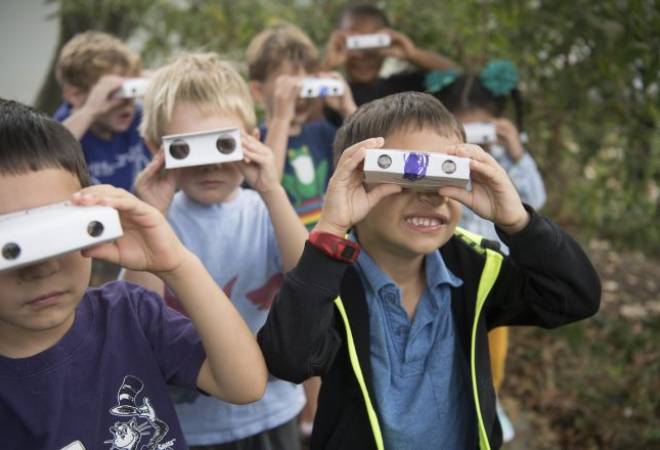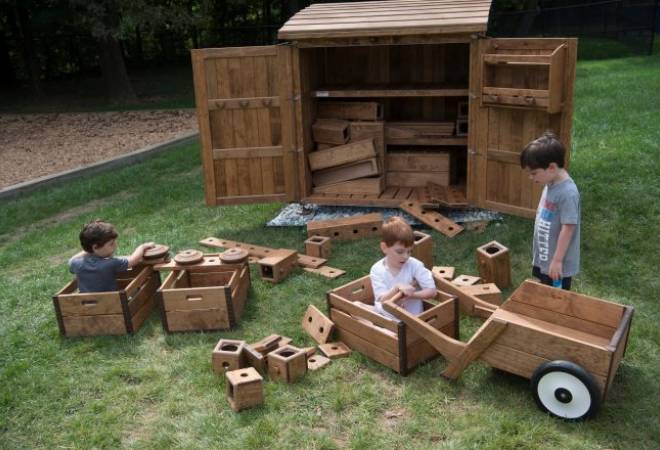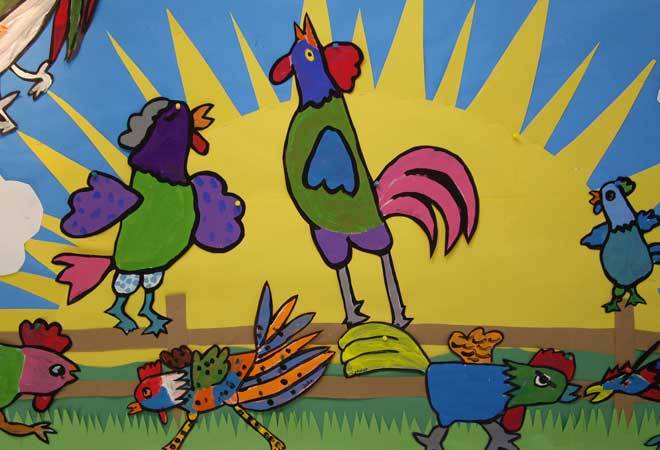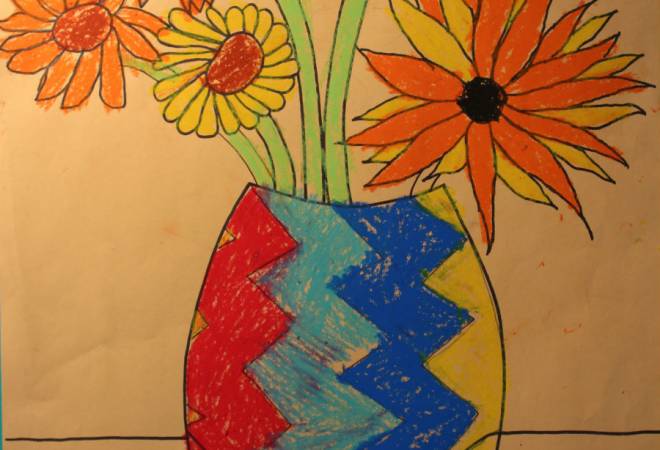Phonovisual Method
The Phonovisual Method has been a mainstay of the Primary Day curriculum from our earliest days. We were founded in 1944 as a demonstration school for the Phonovisual Method, and over the years we have trained thousands of teachers to implement it. Today the Phonovisual Method continues to prove its value, having outlasted countless trends and changes in reading instruction. Primary Day students become very good readers, and the Phonovisual Method is a big reason why that’s the case.
The Phonovisual Method is a phonics-based approach to teaching reading, writing, and spelling which influences the entire Balanced Literacy program and is integrated throughout the curriculum. Taught as a separate subject at every grade level, Phonovisual provides security and confidence as the children develop word attack skills and acquire vocabulary. It is used as a supplementary tool for Reading Workshop, our developmental reading program. Children learn the sound/symbol relationship of the consonants and vowels through stories, poems, games, and songs.
- Pre-K
Pre-Kindergarten
Children are introduced to beginning consonant sounds through stories, poems, games, and activities learning to associate the sound/symbol relationship of the “Quiet Cousins,” “Noisy Cousins,” “Singing Cousins,” and “The Neighbors.” Daily small group Phonovisual instruction, taught as a separate subject, helps children develop phonemic awareness and auditory discrimination as they learn to identify/name words with consonant sounds in the initial position of words. Children learn each of the 26 sounds on the Phonovisual Consonant Chart by the end of the year.
- K
Kindergarten
Children continue to name and identify words with targeted sounds in initial position and work to identify the consonant sounds in the final position as they review the entire Consonant Chart. Phonemic awareness and auditory discrimination are further developed through games and activities. Short vowel sounds are introduced individually while children work in small groups to decode and encode words with cvc, ccvc, and ccvcc patterns. Long vowel sounds are also taught individually following the same sequence of instruction. Children decode and encode words with initial and final consonant sounds. Children are introduced to the secondary consonant spellings on the Consonant Chart. Phonovisual is taught as a separate subject and is integrated across the curriculum, reinforced, and reviewed in the Language Arts/Reading program.
- 1st
First Grade
Repetition and review of all consonant sounds and primary spellings of the short and long vowel sounds continues through games and activities. Children continue to work with secondary spellings on the Consonant Chart. They learn the eight remaining vowel combinations as they work in small groups and as a whole class to decode and encode words with cvc, ccvc, cvcc, ccvcc, cvce and ccvce patterns. Vocabulary development continues along with learning compound words, suffixes, and alphabetizing. Phonovisual is taught as a separate subject and is also integrated across the curriculum, particularly in the Language Arts/Reading program
- 2nd
Second Grade
Children review all primary and secondary spellings on the Phonovisual Consonant Chart and all primary spellings on the Phonovisual Vowel Chart. Children learn the secondary vowel spellings on the Vowel Chart. Weekly spelling lists include target words from units and themes studied across the curriculum. Children learn to analyze words based on foundational Phonovisual skills learned from the Consonant and Vowel Charts to determine if a word can be sounded out or if it needs to be studied. Vocabulary development continues along with learning spelling pattern rules, prefixes, suffixes, syllables, compound words, plurals, and alphabetizing. Children apply Phonovisual skills across the curriculum to encode and decode polysyllabic words. The Language Arts/Reading program also allows for direct application of Phonovisual skills.
Balanced Literacy
Balanced Literacy tops our list of priorities for each child at every grade level. Reading is important in its own right—for knowledge, for pleasure, for personal growth—but it is also a crucial “gateway” skill, opening doors to learning in every other subject. Research shows that children who learn to read well in the early grades are more successful throughout their school years across all of the content areas. From their first days at Primary Day, children learn to unearth the treasures to be found in the library, setting the stage for a lifetime love of learning.
A cornerstone of Balanced Literacy at Primary Day is the Phonovisual Method, a phonics-based system that uses sounds and symbols as language building blocks to unlock children’s capacity to become skilled and confident readers. In addition to the Phonovisual Method, we teach reading at Primary Day using Reading Workshop. Reading Workshop is a research-supported and nationally recognized methodology that contains all the essential elements of Balanced Literacy. We individualize instruction, using small groups and conferences, while introducing children to a variety of genres and skills. Writing instruction at Primary Day begins with basic skills in handwriting letters and words and evolves into reflective journal and story writing, providing students with opportunities to express themselves personally as well as creatively. Reading and writing are taught at every grade level using a rich and varied assortment of literature, genres, themes and authors.
Math
Children make remarkable progress with their math skills during their years at Primary Day, moving from basic number recognition and simple counting in the fall of Pre-Kindergarten to multiplication and division, geometry, algebraic number patterns, and other advanced math concepts and critical thinking skills by the time they finish Second Grade.
The Primary Day School’s math curriculum focuses on building a solid foundation for success by cultivating a positive attitude, developing critical thinking skills, and fostering confidence in learners. Our program utilizes Math in Focus (Singapore Math) materials. Math in Focus follows a sequence of topics that gives students time to fully master foundational math skills. Teachers use a scaffolding approach which adapts instruction to individual learners. Spatial and logical reasoning skills are developed through the use of technology, manipulatives, problem solving, and hands-on activities. At Primary Day, math is integrated at each grade level throughout the curriculum using a wide range of stimulating and engaging methodologies. Our multi-sensory approach to learning gives every child the opportunity to be supported, challenged, and to excel in math.
Science (STEM)
By the time they arrive at Primary Day most children have, by conservative estimate, asked “Why?” at least a thousand times. And if you’re a Primary Day STEM (Science, Technology, Engineering and Math) teacher, that’s a very good thing, because the innate curiosity and sense of wonder children bring with them to school provide fertile ground for our science curriculum. The curriculum is built around questions—questions such as What’s going on here? (observation), What other thing is like this? (classification), and What do you think will happen if you try this? (hypothesis). Those questions are at the core of that time-honored process we call the Scientific Method.
We are firm believers that the best way to learn science is to do science. Students practice scientific problem-solving by doing experiments in small groups in the science lab. Or they venture outside to get their feet wet, doing hands-on projects in and around the school. In Pre-K, students use the Eco-Wonder curriculum which has a team-building and experiential approach with units focusing on gardening, recycling, composting, Earth Science, simple machines, chemistry, and ecosystems. Students learn about sustainability in the context of their lives and how it can better the world at large.
STEM is Primary Day’s integrated, hands-on and collaborative approach to teaching science in Kindergarten through Grade 2. Children learn what makes a good habitat for animals and measure the human impact on the ecosystem. The science lab is home to the engineering center where students work with units from the Boston Museum of Science’s “Engineering is Elementary” curriculum. They build bridges, clean oil spills, pollinate, make better playdough, and create windmills as they explore the engineering design process: ask, imagine, plan, create, improve. Our teachers make STEM lessons exciting and relevant for students using SMART boards, interactive websites, iPads, robotics, LEGOs, games and myriad building materials.
Inside or outside the classroom, our science curriculum taps students’ sense of wonder, helps them better understand the world around them, and lays the foundation for a lifelong appreciation of what science contributes to their lives.
Social Studies
The Primary Day School sits a few miles from one of the most international of cities on our increasingly interconnected planet. The goal of our social studies curriculum is to introduce our students to that planet and some of the people who live on it.
Primary Day children explore a wide variety of cultures and civilizations. They read maps and learn why geography matters. We integrate social studies with music and the arts, and that combination translates into hands-on learning through celebrations such as Mexican Feasts, French Brunches, and other activities, with children wearing the clothes, singing the songs, and getting a literal taste of another part of the world.
The curriculum helps students gain a greater understanding of—and a greater sense of their place in—this diverse and interdependent world. They develop an appreciation for different cultures, including their own and those of their classmates. And in the process they learn about—and practice—good citizenship.
Art
Everyone’s an artist at Primary Day, and lively imaginations find creative expression in a wide range of ways. Children explore color, shape, composition, and perspective through projects that introduce them to different art media and techniques, from sponge painting and watercolor to weaving, pottery, and sculpture with “found” or recycled materials. They advance from working with simple shapes early in Pre-Kindergarten to sophisticated projects where they study famous artists and experiment with their styles. School hallways are perpetual art galleries, with colorful creations always on display. And throughout, we aim to nurture children’s creative energies, building their confidence in their ability to express themselves.
Physical Education
Primary Day offers a fun and engaging physical education curriculum that teaches skills and builds self-confidence, educating children’s bodies along with their minds. The curriculum builds motor skills and other movement abilities through games and sports activities. Students learn the connection between physical activity and health, and learn to practice good health habits. Sports and games teach teamwork and cooperation through the STAR (Sportsmanship, Teamwork, Attitude, Respect) values. And throughout all physical education activities, that “fun” part remains a very high priority.
Music
The Primary Day music curriculum builds on children’s natural love of music by offering a broad array of opportunities to explore sounds through singing, moving, listening, and playing instruments. We use songs, singing games, and circle dances to introduce children to basic musical concepts of rhythm, melody, tempo, and dynamics. They develop an appreciation for different kinds of music, including traditional children’s songs, folk songs, classical music, and music from a variety of cultures, styles and time periods. Singing is a vital part of the music program. Instrumental instruction follows the Orff-Schulwerk methodology and uses speech, body percussion, percussion instruments and recorder. The music program coordinates with each grade level to support the classroom thematic curriculum. The music teacher draws on her expertise as an educator and a musician, adapting a variety of proven teaching methods to individualize instruction. Throughout the school year, children have ample opportunities to showcase their talents for the entire school community, gaining self-confidence and poise by performing at assemblies, plays, grade level programs, and other school events.
Spanish
Exposure to languages broadens world views and enhances a child’s sense of curiosity about the world. Research has also found that speaking an additional language has several positive cognitive impacts, with wide implications on a range of disciplines -- including human brain health. Language learning helps improve children's thinking skills and memory abilities, as well as neuroplasticity.
At Primary Day, students are exposed to Spanish beginning in Pre-Kindergarten. The emphasis of our program is on receptive language, or listening skills, and speaking so that children become confident and comfortable being immersed in the target language. Spanish is taught through a variety of kinesthetic, visual, and auditory activities. Many units relate to what the children study in other subject areas. Through a variety of activities, games, stories, and music, students listen, speak, story tell, and sing while gaining exposure to Hispanic culture and everyday use of the Spanish language.
Technology
You would be hard-pressed to find an aspect of today’s world that hasn’t been touched in significant ways by technology. That’s why it’s important from the earliest grades to start building children’s comfort with technology and their skill and confidence using it.
Technology at Primary Day is fully integrated into our classrooms utilizing SMART Boards, iPads and other tools. Classroom teachers make lessons exciting and relevant for students using interactive websites and games. Children are exposed to use of robotics, LEGO, and KNEX.
By the time they graduate, Primary Day students understand the important role information technology can play in their learning lives, and they have a toolbox of skills that will serve them well in the future.
Social-Emotional Learning
Social-emotional learning (SEL) is the process through which children acquire the knowledge, attitudes, and skills to manage emotions, achieve goals, demonstrate empathy, build positive relationships, and make responsible decisions. At Primary Day, integrating social-emotional learning into our curriculum is foundational to our goal of educating the whole child in these most important years.
We resolutely employ Responsive Classroom, an evidence-based teaching approach that fosters social-emotional skills, attitudes, and behaviors through engaging academics, positive community building, effective relationship management and developmental awareness of the special age group we serve.
Responsive Classroom at Primary Day includes:
- Interactive Modeling: An explicit practice for teaching procedures and routines as well as academic and social skills.
- Effective Teacher Language: The intentional use of language to enable students to engage in their learning and develop the academic, social, and emotional skills they need to be successful.
- Academic Choice: A strategy for structuring lessons and activities that increases students’ motivation and skills and builds a sense of community in the classroom. When teachers use Academic Choice, children become purposeful, competent learners who connect to each other in positive ways.
- Logical Consequences: A non-punitive response to misbehavior that allows teachers to set clear limits and students to learn from their mistakes while maintaining their dignity.
- Interactive Learning Structures: Coordinated activities that give students opportunities to engage with content in hands-on and social ways.
- Respect, Resourcefulness, Responsibility and Resilience: Explicit social constructs that engage children as collaborative, caring learners and friends.
With their teachers, our young scholars practice the following tenets of Responsive Classroom:
- Morning Meeting: A gathering at the beginning of each school day that proceeds through four sequential components: greeting, sharing, group activity, and morning message.
- Goal and Rule Development: Teachers and students work together to name individual goals and establish rules that will help everyone reach those goals.
- Energizers: Short, playful, whole-group activities that are used as breaks in lessons.
- Quiet Time: A brief, relaxed time of transition that takes place after lunch and recess, before the rest of the school day continues.
- Closing Circle: A gathering at the end of the day that promotes reflection and celebration through participation in brief activities.
- Schoolwide Assembly: Monthly assemblies offer the entire community opportunities to explore real life virtues, including: empathy, courage, honesty, perseverance, and friendship.
Primary Day’s commitment to social-emotional learning supports a culture of self-management, equipping our students with a sense of belonging and worth that enables them to thrive in and out of the classroom. Additional information and resources are available at:
The Collaborative for Academic, Social, and Emotional Learning (CASEL)
Responsive Classroom
Yardsticks, by Chip Wood


























































